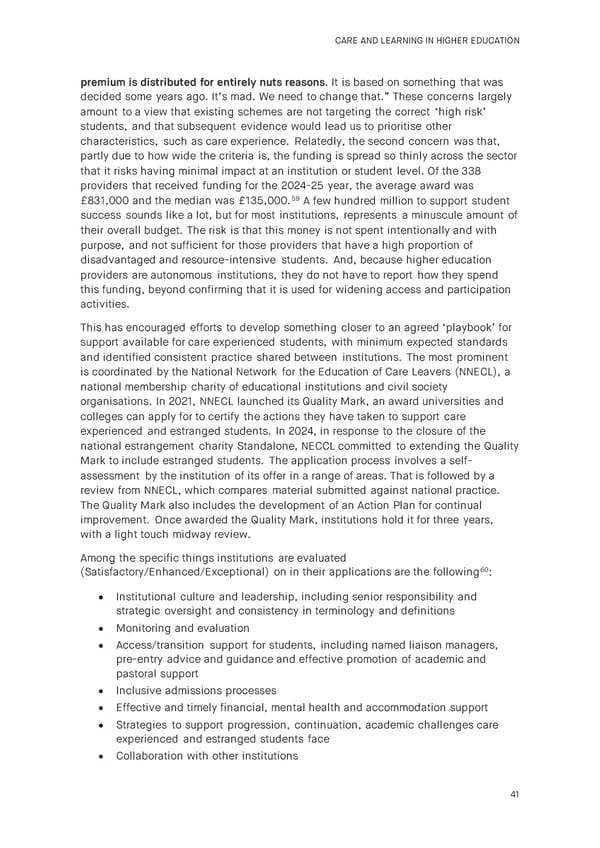CARE AND LEARNING IN HIGHER EDUCATION premium is distributed for entirely nuts reasons. It is based on something that was decided some years ago. It’s mad. We need to change that.” These concerns largely amount to a view that existing schemes are not targeting the correct ‘high risk’ students, and that subsequent evidence would lead us to prioritise other characteristics, such as care experience. Relatedly, the second concern was that, partly due to how wide the criteria is, the funding is spread so thinly across the sector that it risks having minimal impact at an institution or student level. Of the 338 providers that received funding for the 2024-25 year, the average award was £831,000 and the median was £135,000.59 A few hundred million to support student success sounds like a lot, but for most institutions, represents a minuscule amount of their overall budget. The risk is that this money is not spent intentionally and with purpose, and not sufficient for those providers that have a high proportion of disadvantaged and resource-intensive students. And, because higher education providers are autonomous institutions, they do not have to report how they spend this funding, beyond confirming that it is used for widening access and participation activities. This has encouraged efforts to develop something closer to an agreed ‘playbook’ for support available for care experienced students, with minimum expected standards and identified consistent practice shared between institutions. The most prominent is coordinated by the National Network for the Education of Care Leavers (NNECL), a national membership charity of educational institutions and civil society organisations. In 2021, NNECL launched its Quality Mark, an award universities and colleges can apply for to certify the actions they have taken to support care experienced and estranged students. In 2024, in response to the closure of the national estrangement charity Standalone, NECCL committed to extending the Quality Mark to include estranged students. The application process involves a self- assessment by the institution of its offer in a range of areas. That is followed by a review from NNECL, which compares material submitted against national practice. The Quality Mark also includes the development of an Action Plan for continual improvement. Once awarded the Quality Mark, institutions hold it for three years, with a light touch midway review. Among the specific things institutions are evaluated (Satisfactory/Enhanced/Exceptional) on in their applications are the following60: • Institutional culture and leadership, including senior responsibility and strategic oversight and consistency in terminology and definitions • Monitoring and evaluation • Access/transition support for students, including named liaison managers, pre-entry advice and guidance and effective promotion of academic and pastoral support • Inclusive admissions processes • Effective and timely financial, mental health and accommodation support • Strategies to support progression, continuation, academic challenges care experienced and estranged students face • Collaboration with other institutions 41
 Care and Learning in Higher Education Page 41 Page 43
Care and Learning in Higher Education Page 41 Page 43